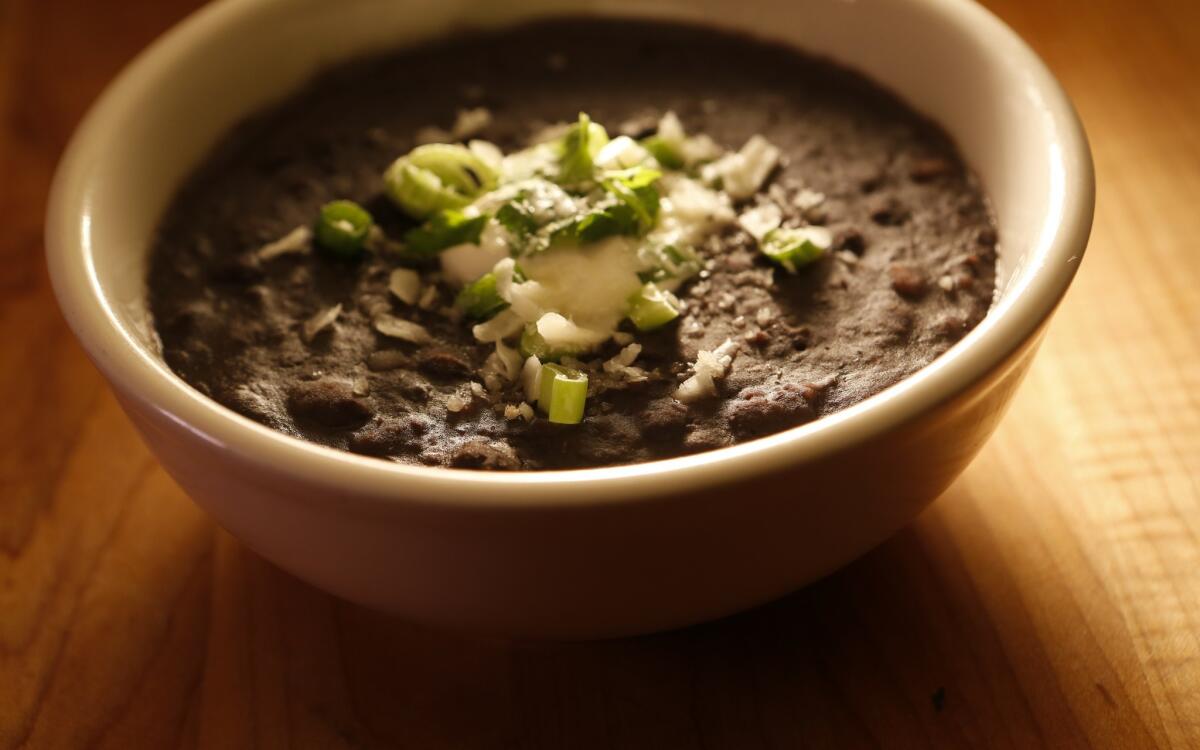Smoky black bean stew

- Share via
Rich, earthy, hearty — there’s nothing quite so reassuring as having a pot of beans simmering in the oven when cool weather comes along. So why don’t more people cook them? One of the main reasons is the planning that’s required to soak them overnight before you start. I know the look — the idea that some people have meals planned a day in advance continues to astonish me.
But here’s the thing: In most cases you don’t need to. Many years ago I set out to discover if there wasn’t some way to shortcut the soaking and cooking process. What I learned surprised me. And it has allowed me to fix up a pot of beans for dinner whenever I like.
“Almost every recipe in every cookbook you’ve ever read says you must soak dried beans before you cook them. In almost every case that advice is wrong.” That’s what I wrote when I first ran the experiments 20 years ago. And it’s true.
For most dried beans, you can simply put them straight into a pot and simmer them until tender without any soaking at all. Not only is it more convenient, it actually improves them. A lot. Beans cooked without soaking have a richer, fuller flavor. They taste more “beany.” And the cooking broth is rich and thick as well.
I can’t claim this as my discovery, not when it’s the way many Mexican cooks have been fixing beans for centuries. It’s just knowledge that somehow had fallen by the wayside (just as we’ve forgotten that, as every Indian and Persian cook knows, we should soak long-grain rice for an hour or so before cooking).
Doing without soaking does increase beans’ cooking time — but for most varieties that’s only by a matter of 20 to 30 minutes, and that’s unaccompanied time anyway. Black beans, pinto beans, Great Northern beans, cannellini beans, navy beans, they all cook without a whiff of trouble.
There are a couple of caveats. First, if you’re using very old beans — ones that have been in the back of your pantry for a year or so, or that you bought from a store that doesn’t turn over its stock — then they might have dried out so much that soaking is advisable.
And there are some types of beans that do require soaking. I still soak chickpeas, of course (not technically a bean but a legume, so there you are).
I also talked to my favorite bean expert, Steve Sando of Rancho Gordo (if you haven’t tried its specialty beans, you’re missing something). He said that, in general, he recommends always soaking beans from the runner species, Phaseolus coccineus. These are extremely large, dense beans that will become beautifully creamy when cooked — but they do need soaking to soften in a reasonable manner of time.
Also, not soaking works best for beans for soups or stews. If you’re going to be using the beans in salads or other dishes in which you want them to be separate and distinct, you should either soak them or at the very least give them a rinse after they’ve cooked.
You want proof? Cook these black beans soaked and unsoaked and compare the two. Whenever I serve this recipe, people ask me what the secret ingredient is. And since cooking it without soaking requires all of 10 minutes to put together, it’s actually something you can fix all the time.
Imagine that. An everyday pot of beans.
russ.parsons@latimes.com
Heat the oven to 325 degrees. In a heavy pot or Dutch oven over medium heat, bring the black beans, water, chiles, onions, garlic and bay leaf to a simmer. Cover tightly and transfer to the oven.
Cook for 1 hour, then add 1 teaspoon salt and a generous grinding of black pepper and stir to combine. Re-cover the pot and return it to the oven to cook until the beans are tender and creamy, 30 to 45 more minutes.
Use an immersion blender to coarsely purée the beans just enough to release some of the starch. Alternatively, purée 1 cup of beans in a stand blender and return them to the pot. Heat just until the beans have thickened. (The dish can be prepared to this point several days in advance and refrigerated, tightly sealed.)
When ready to serve, bring the beans back to a simmer. Add a little more water if they are too thick. Taste and correct seasoning with salt and pepper.
Ladle the beans into warmed serving bowls and garnish with a spoonful of crema Mexicana, a sprinkling of green onions and cilantro, and grated cotija cheese, with more passed at the table. Serve immediately.
Get our Cooking newsletter
Get a taste of Los Angeles — and the world — with recipes and kitchen tricks from the L.A. Times’ Cooking newsletter.
You may occasionally receive promotional content from the Los Angeles Times.
















